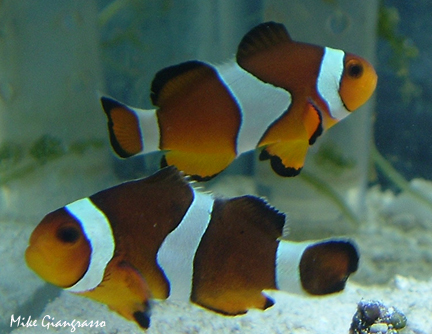|
| 질의: anemonefish | 결과: 62번째/113 | |
Clown Anemonefish / Ocellaris Clownfish (Amphiprion ocellaris) - Wiki
| 제목: | Clown Anemonefish / Ocellaris Clownfish (Amphiprion ocellaris) - Wiki
| |

| 해상도: 432x334
파일크기: 141647 Bytes
촬영일: 2003:10:05 09:44:59
사진기: FinePix A205 (FUJIFILM)
F number: f/3.2
Exposure: 10/1000 sec
Focal Length: 640/100
등록시간: 2007:01:03 00:05:19
|
Ocellaris clownfish
From Wikipedia, the free encyclopedia
[Photo] Young pair of False Percula Clownfish, Amphiprion ocellaris photograohed in the aquarium of aquarist Mike Giangrasso.
The Ocellaris clownfish (Amphiprion ocellaris) or false Percula clownfish is a popular aquarium fish. It is very closely related to the Percula clownfish and often lives in association with the sea anemone Heteractis magnifica, using them for shelter and protection. Generally, Ocellaris clownfish are hardier, and slightly less aggressive than its Percula counterpart. Both species are found in coral reefs around the world, particularly in the Fiji and Tonga regions.
Behavior
The commensalism between anemonefish and anemones depends on the presence of the fish drawing other fish to the anemone, where they are stung by its poisonous tentacles. The anemone helps the fish by giving it protection from predators, which include brittle stars, wrasses, and other damselfish, and the fish helps the anemone by feeding it, increasing oxygenation, and removing waste material from the host. Studies carried out at Marineland of the Pacific by Dr. Demorest Davenport and Dr. Kenneth Noris in 1958 revealed that the mucus secreted by the anemone fish prevented the anemone from discharging its lethal stinging nematocysts. The fish feeds on algae, zooplankton, worms, and small crustaceans.
Description
This clown anemonefish can be recognised by its orange colour with three white bars and black markings on the fins. It grows to about eight centimeters (three inches) in length. One can differentiate between Percula (true) and Ocellaris (false) by their respective colors and patterns. Ocellaris are usually less vibrantly colored, and have 11 dorsal fin-spines instead of 10, as on the Percula.
Reproduction
Since these fish live in a warm water environment they can reproduce year-round. Each group of fish consists of a breeding pair and 0-4 non-breeders. Within each group there is a size-based hierarchy: the female is largest, the male is second largest, and the non-breeders get progressively smaller as the hierarchy descends. If the female dies, the male changes sex, becomes the breeding female and the largest non-breeder becomes the breeding male.
It has been unclear why the non-breeders continue to associate with these groups. Unlike non-reproductives in some animal groups, they cannot obtain occasional breeding opportunities, because their gonads are non-functional. They cannot be regarded as helpers at the nest, since it has been found their presence does not increase the reproductive success of the breeders. Recent research (Buston, 2004) suggests that they are simply queueing for the territory occupied by the breeders, i.e. the anemone; nonbreeders living in association with breeders have a better chance of eventually securing a territory than a non-resident.
The development of the fish from juvenile to adult is dependent on the system of hierarchy. There is aggression involved in these small families although usually not between the male and the females. The aggression usually is between the males. The largest male will bully the next smallest male and the cycle continues until the smallest fish leaves the host anemone. Amphiprion ocellaris are very competitive fish and this causes the smaller fish to have a stunted growth. However in an aquarium, this fish is peaceful, and it can live in an aquarium environment well.
The fish lay their eggs in a safe spot close to the anemone for protection; it usually takes 6-7 days for the eggs to hatch. During this time the male is very protective over the nest. The mother usually lays the eggs in the morning. The process usually lasts for about half an hour and 100 to 1000 eggs are deposited. The male fertilizes the eggs as they are laid.
http://en.wikipedia.org/wiki/Ocellaris_clownfish
| The text in this page is based on the copyrighted Wikipedia article shown in above URL. It is used under the GNU Free Documentation License. You may redistribute it, verbatim or modified, providing that you comply with the terms of the GFDL. |
|
^o^
동물그림창고 똑똑전화 누리집
^o^
|
|

